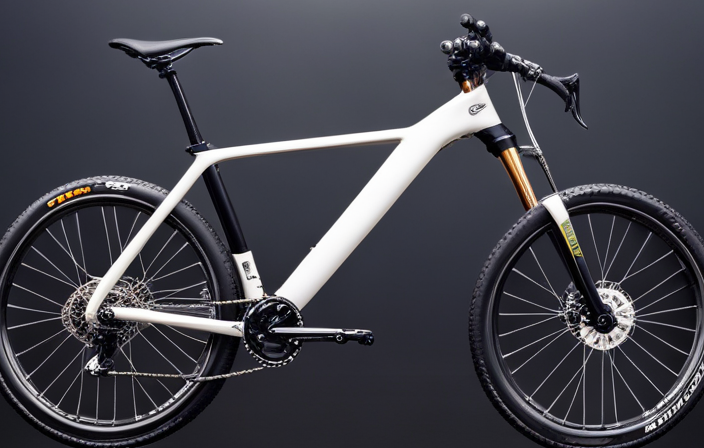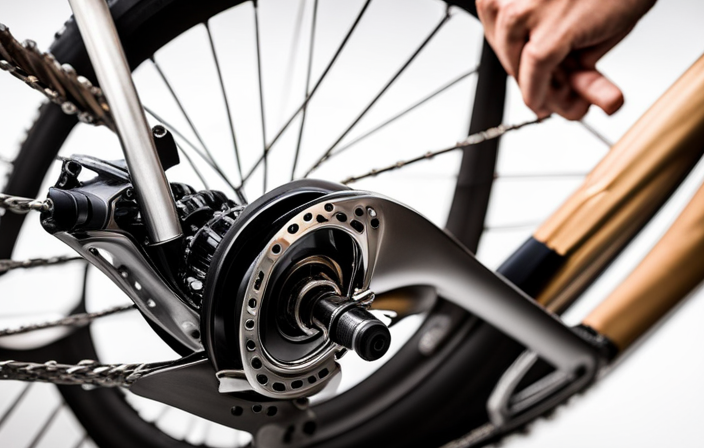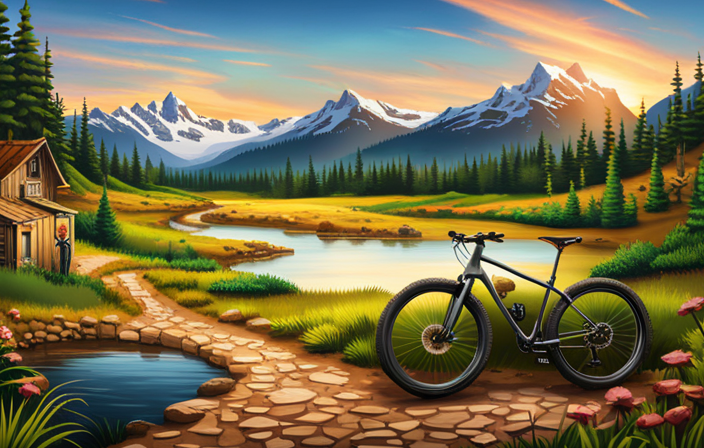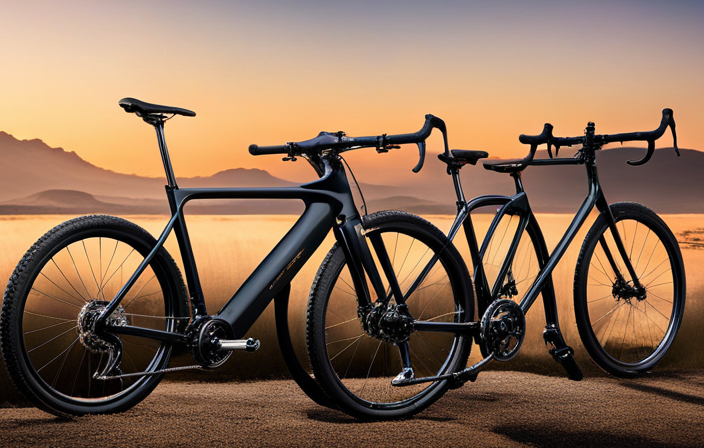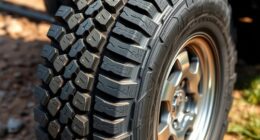You may be wondering, “Why do I require a dedicated bike for gravel roads? Can’t any bike manage it?”
Well, let me tell you, my friend, gravel riding is a whole different ball game. The uneven surfaces and unpredictable terrain demand a bike that can handle the challenge with ease.
In this article, we’ll explore the various types of bikes suitable for gravel roads, considering factors like frame material, tire width and tread patterns, suspension options, brake systems, maintenance considerations, accessories and upgrades.
So buckle up and get ready to find your perfect ride!
Key Takeaways
- Gravel bike, cyclocross bike, and gravel race bike are suitable options for riding on gravel roads.
- Frame materials such as aluminum, steel, carbon fiber, and titanium offer different benefits in terms of weight, durability, and comfort.
- Wide tires with knobby tread patterns and tubeless technology provide stability, traction, and puncture resistance on gravel surfaces.
- Suspension options like hardtail bikes with front suspension and different fork options can enhance comfort and control on rough terrain.
Types of Bikes Suitable for Gravel Roads
If you’re looking to ride on gravel roads, you’ll want to consider the different types of bikes that are suitable for this terrain. Gravel cycling has gained popularity in recent years, with more and more people seeking adventure on unpaved paths.
One type of bike that is commonly used for gravel riding is the gravel bike itself. These versatile machines are designed specifically for off-road adventures and can handle a variety of terrains. Gravel bikes typically have wider tires than road bikes, allowing for better traction and stability on loose surfaces. They also have a more relaxed geometry, providing a comfortable riding position during long rides. Additionally, many gravel bikes come equipped with mounting points for bikepacking gear, making them ideal companions for multi-day trips.
Another option to consider is the cyclocross bike. Originally designed for racing through muddy fields and over obstacles, cyclocross bikes excel on rough terrain like gravel roads. With their lightweight frames and aggressive treaded tires, these bikes offer great maneuverability and control.
Lastly, if you’re interested in participating in gravel road races, you may want to consider a dedicated gravel race bike. These machines are built with speed in mind and feature aerodynamic designs and lightweight components.
When choosing a bike for gravel roads, it’s important to also consider the frame material. Each material has its own characteristics that can impact your ride experience. Now let’s delve into this aspect further as we explore which frame material might be best suited for your needs.
Consider the Frame Material
When considering the frame material, you should look for one that suits your needs and preferences. The frame material plays a crucial role in determining the durability and weight of the bike. There are various options available, each with its own pros and cons.
Aluminum frames are popular due to their lightness and affordability. They offer good strength-to-weight ratio, making them ideal for gravel riding. However, they can be less forgiving on rough terrain compared to other materials.
Steel frames are known for their durability and smooth ride quality. They provide excellent shock absorption, which is beneficial when riding on gravel roads. Steel frames tend to be heavier than aluminum but offer unmatched longevity.
Carbon fiber frames are lightweight and provide a comfortable ride experience. These frames excel in absorbing vibrations from rough surfaces, enhancing comfort during long rides. However, they can be more expensive compared to other materials.
Titanium frames combine the best of both worlds by offering durability similar to steel but with the weight closer to aluminum. They have excellent fatigue life and corrosion resistance.
In conclusion, when choosing a bike for gravel roads, it’s important to consider the frame material that best suits your needs. Frame material comparison involving factors like durability and weight analysis will help you make an informed decision about which bike is right for you based on your preferences and riding style.
Now let’s turn our attention to tire width and tread patterns…
Tire Width and Tread Patterns
When it comes to choosing the right tire width and tread patterns for gravel roads, there are several key points to consider.
Wide tires are essential for stability, providing a larger contact patch with the ground and allowing for better control over rough terrain.
Additionally, knobby tread patterns offer superior traction by digging into loose surfaces and providing grip in muddy conditions.
Lastly, opting for tubeless tires can greatly enhance puncture resistance, as they eliminate the risk of pinch flats and allow for lower tire pressures without sacrificing performance.
Wide Tires for Stability
For better stability, you should consider getting a bike with wider tires. Wide tires provide more surface area, which enhances traction and stability on gravel roads.
When riding on uneven terrain, it’s important to adjust your tire pressure accordingly. Lowering the tire pressure creates a larger contact patch with the ground, giving you better control and reducing the risk of slipping.
Additionally, wider tires allow for more room to fit gravel bike accessories such as fenders or pannier racks, making them ideal for longer rides or bikepacking adventures. However, it’s crucial to find the right balance between width and weight, as excessively wide tires can slow you down on paved sections.
Transitioning into the next section about knobby tread patterns for traction, it’s worth noting that tire width alone is not enough; you also need an appropriate tread pattern to maximize grip in off-road conditions.
Knobby Tread Patterns for Traction
To maximize traction on uneven terrain, you’ll want to consider using tires with knobby tread patterns. Knobby tread patterns provide the necessary grip on loose surfaces, such as gravel and dirt roads. They have deep grooves and protruding knobs that dig into the ground, giving you better control and stability.
For optimal performance on off-road gravel terrain, there are a few tire choices that are highly recommended. The first is the Maxxis Rambler, which offers excellent grip and durability with its aggressive tread pattern. Another great option is the WTB Nano, known for its versatility and ability to handle various terrains. These tires will ensure you have the traction needed for a thrilling gravel adventure.
Now let’s talk about tubeless tires for puncture resistance…
Tubeless Tires for Puncture Resistance
Tubeless tires provide increased puncture resistance and can greatly enhance your riding experience. With no inner tube to worry about, you can ride with confidence on rough gravel roads without the fear of getting a flat tire. Not only do tubeless tires offer better puncture protection, but they also allow you to run lower tire pressures for improved traction and comfort.
To help you understand the benefits of tubeless tires and how to install them properly, let’s take a closer look at the following table:
| Tubeless Tire Benefits | Tubeless Tire Installation Tips |
|---|---|
| Enhanced puncture resistance | Use sealant for added protection |
| Lower tire pressure | Follow manufacturer’s instructions |
| Improved traction | Ensure proper rim tape placement |
| Greater comfort | Check for leaks after installation |
| Reduced rolling resistance | Invest in a quality tubeless-ready tire |
By following these tips, you’ll be able to enjoy all the advantages that tubeless tires have to offer. Now let’s explore suspension options for a smoother ride on those gravel roads.
Suspension Options
One option is a hardtail bike with front suspension. These bikes are designed to handle rough terrain while providing some level of comfort and control. When considering suspension compatibility, it’s important to look at the fork options available for the bike. There are different types of forks, such as air forks or coil forks, each offering its own benefits and drawbacks.
Air forks are lightweight and can be adjusted to match your weight and riding style. They provide a responsive feel and offer good performance on gravel roads. On the other hand, coil forks are known for their durability and ability to absorb big hits. They may be slightly heavier but offer a plush ride that can smooth out rough surfaces.
When choosing between suspension options for a gravel bike, consider the type of terrain you’ll be riding on most frequently. If you’ll encounter more technical sections with larger obstacles, a hardtail bike with front suspension might be the better choice. However, if you plan on tackling long distances or smoother gravel roads, a rigid fork might suffice.
Transitioning into the next section about brake systems, it’s important to have reliable stopping power when riding on gravel roads.
Brake Systems
When riding on gravel, you need reliable stopping power, so it’s important to choose a brake system that will give you the control and confidence you need. When it comes to brake performance on gravel roads, there are two main options to consider: hydraulic brakes and mechanical brakes.
-
Hydraulic Brakes: These brakes offer exceptional stopping power and modulation, making them ideal for off-road riding. The hydraulic fluid transfers force from the lever to the caliper, resulting in consistent and powerful braking even in wet or muddy conditions. They require minimal maintenance and provide a smooth and responsive feel.
-
Mechanical Brakes: These brakes use cables to transfer force from the lever to the caliper. While they may not offer the same level of stopping power as hydraulic brakes, they can still provide reliable performance on gravel roads. Mechanical brakes are easier to maintain and repair, making them a good choice for riders who prefer DIY maintenance.
-
Personal Preference: Ultimately, choosing between hydraulic and mechanical brakes will depend on your personal preference and riding style. If you prioritize maximum brake performance and don’t mind the additional cost, hydraulic brakes are an excellent option. However, if simplicity and ease of maintenance are more important to you, mechanical brakes may be a better fit.
Transitioning into the subsequent section about gearing options: Now that we’ve explored brake systems for gravel bikes, let’s move onto discussing gearing options that can enhance your riding experience even further.
Gearing Options
When it comes to gravel riding, having the right gearing options is crucial to ensure a smooth and efficient ride. The gears on your bike determine how well you can tackle different terrains and gradients, so it’s important to choose wisely.
Gearing ratios refer to the difference in size between the front chainrings and rear cassette cogs. A wider range of ratios allows you to easily switch between high gears for flat sections and low gears for steep climbs. This versatility is especially important when riding on unpredictable gravel roads where conditions can change rapidly.
A bike with a wide gear range will make it easier for you to maintain a comfortable cadence throughout your ride, regardless of the terrain. Look for bikes that offer a good balance between high-end speed options and low-end climbing capabilities.
Finding the right gearing options depends on your individual preferences and fitness level. Some riders prefer a wider gear range with smaller steps between gears, while others prioritize larger jumps between gears for smoother shifting.
Now that we’ve covered gearing options, let’s move on to discussing bike fit and geometry, which play an equally important role in finding the perfect gravel bike for your needs.
Bike Fit and Geometry
Let’s now delve into the importance of bike fit and geometry when choosing the perfect gravel ride. When it comes to riding on gravel roads, having a properly fitted bike is crucial for comfort and performance. A well-fitted bike allows for efficient power transfer and reduces the risk of injury or discomfort during long rides.
One aspect of bike fit that should be considered is making necessary adjustments to ensure your body is in the optimal position. This includes adjusting saddle height, handlebar position, and reach. These adjustments can help prevent strain on your joints and muscles, allowing you to ride longer without fatigue.
Furthermore, optimizing bike fit can also enhance your control and handling on rough terrain. The geometry of a gravel bike plays a significant role in how it handles different surfaces. A more relaxed geometry with a longer wheelbase provides stability at higher speeds and better traction on loose surfaces.
Transitioning to weight considerations, it’s important to note that while bike fit plays a vital role in comfort and performance, the weight of the bike itself can also impact your overall experience on gravel roads.
Weight Considerations
To optimize your experience on gravel, it’s important to consider the weight of your ride. The weight of a bike can significantly impact its performance on gravel roads. Here are four reasons why bike weight matters:
-
Handling: A lighter bike is easier to handle and maneuver, especially on unpredictable terrain. It allows for quicker acceleration and better control in tight turns.
-
Climbing: Gravel roads often have steep hills, and a lighter bike makes climbing much more manageable. With less weight to carry up the incline, you’ll expend less energy and maintain better momentum.
-
Speed: On flat sections or descents, a lighter bike can help you achieve higher speeds with less effort. It allows for easier acceleration and maintains momentum more efficiently.
-
Fatigue: Riding long distances on gravel can be physically demanding, so reducing the weight of your bike can help minimize fatigue. This means you’ll have more energy to enjoy the ride and tackle challenging sections.
Considering these factors, it’s clear that choosing a lightweight bike for gravel riding is beneficial for overall performance. Transitioning into the next section about price range, it’s also worth noting that while lighter bikes may come at a higher cost, they offer significant advantages that make them worth considering for serious riders seeking optimal performance on gravel roads.
Price Range
When considering the price range for gravel bikes, there are three main categories to look at: entry-level options, mid-range bikes, and high-end models.
Entry-level options are typically more affordable and may have basic components, but they still offer a reliable ride for those just getting started on gravel roads.
Mid-range bikes offer a step up in terms of quality and performance, with better components and features that enhance the riding experience.
High-end models are top-of-the-line bikes designed for serious riders who want the best technology, materials, and performance available.
Entry-Level Options
There’s a variety of entry-level options available for gravel road biking. When it comes to bike brands, some popular choices in the budget options include Giant, Specialized, and Cannondale. These brands offer reliable and durable bikes that are perfect for beginners or those on a tight budget.
One key aspect to consider is the frame material, with aluminum being a common choice due to its affordability and strength. Entry-level gravel bikes usually come equipped with wider tires for better stability on rough terrains, as well as disc brakes for enhanced stopping power. Additionally, they often feature versatile gearing systems that allow you to tackle different types of terrain with ease.
Transitioning into the subsequent section about mid-range bikes, these options provide even more advanced features and technologies without breaking the bank.
Mid-Range Bikes
If you’re looking to upgrade your entry-level bike, mid-range options offer more advanced features and technologies without breaking the bank. These bikes are a great choice for riders who want to take their gravel adventures to the next level.
Here are three budget-friendly mid-range bikes that will enhance your riding experience:
-
Suspension: Mid-range bikes often come equipped with front suspension forks that absorb shocks and provide a smoother ride on uneven terrain.
-
Gear range: These bikes typically have a wider gear range, allowing you to tackle steep climbs and fast descents with ease.
-
Disc brakes: Mid-range models often feature disc brakes, which provide better stopping power and control in all weather conditions.
With these bike features and budget options available, you can enjoy improved performance and comfort on gravel roads without breaking the bank.
Now let’s delve into high-end models that offer even more advanced features for the avid gravel cyclist.
High-End Models
For the avid gravel cyclist, high-end models offer an array of advanced features to enhance your riding experience. These top-of-the-line bikes are designed with the latest technology and materials, making them lighter, stiffer, and more durable than mid-range options.
One key feature of high-end models is their ability to handle rough terrains with ease. They often come equipped with wider tires for better traction and larger clearance for mud and debris. Additionally, these bikes have upgraded components such as carbon fiber frames, hydraulic disc brakes, and electronic shifting systems that provide smoother gear changes and better overall performance.
When it comes to performance comparison, high-end models outshine mid-range bikes in terms of speed, responsiveness, and comfort. With their superior construction and cutting-edge features, these bikes allow riders to conquer challenging gravel roads effortlessly.
Now let’s explore some test riding and demo opportunities available for those who want to experience these exceptional machines firsthand.
Test Riding and Demo Opportunities
I’ll be sure to check out the local bike shops for test riding and demo opportunities. It’s always a good idea to take a bike for a spin before making a purchase, especially when it comes to high-end models. Test riding allows you to get a feel for the bike’s handling, comfort, and overall performance on gravel roads.
When looking for test ride advantages, finding local dealers is key. Local dealers often have a variety of bikes available for test rides, allowing you to compare different models and find the perfect fit for your needs. They also have knowledgeable staff who can provide valuable insights and recommendations based on your preferences.
During my visit to the bike shops, I’ll keep an eye out for specific features that are important for gravel road riding. Some sub-lists I will be paying attention to include:
- Frame material: Is it durable enough to handle rough terrain?
- Tire clearance: Are there provisions for wider tires that provide better traction?
- Brake options: Are disc brakes available? They offer better stopping power in muddy or wet conditions.
By taking advantage of these test riding opportunities, I can gather all the necessary information needed before embarking on my upcoming bikepacking adventures.
Considerations for Bikepacking Adventures
After thoroughly testing and demoing various gravel bikes, I have finally found the perfect one for my adventures on gravel roads. Now, it’s time to take my biking experience to the next level by considering bikepacking.
Bikepacking allows me to explore new areas, camp out under the stars, and truly immerse myself in nature. But before embarking on this exciting journey, there are a couple of considerations I need to keep in mind.
Firstly, I need to invest in proper bikepacking gear. This includes lightweight camping equipment such as a tent, sleeping bag, and cooking supplies that won’t weigh me down during long rides. Additionally, I’ll need to carefully plan my routes, considering factors like terrain difficulty and water sources along the way.
Route planning is crucial for a successful bikepacking adventure. It allows me to anticipate any challenges or obstacles I may face during my trip and ensures that I have access to essential resources throughout my journey.
As I prepare for my first bikepacking adventure, it’s important not only to focus on the excitement but also on maintenance and repair considerations.
Maintenance and Repair Considerations
Before embarking on your bikepacking adventure, it’s important to consider the maintenance and repair aspects of your journey. Ensuring that your bike is in good condition and equipped with the necessary tools can make a significant difference in your overall experience. Here are some key points to keep in mind:
-
Regular bike maintenance: Regularly cleaning and lubricating your bike will help prevent wear and tear, ensuring optimal performance throughout your trip.
-
Basic repair tools: Carrying essential repair tools such as a multi-tool, tire levers, spare tubes, and a pump is crucial for fixing common issues like flat tires or loose bolts.
-
Knowledge of repairs: Familiarize yourself with basic repairs such as fixing a chain or adjusting brakes. Knowing how to handle common problems can save you time and frustration on the road.
-
Emergency repair kit: It’s wise to have an emergency repair kit that includes items like patch kits, zip ties, duct tape, and extra bolts. These can be lifesavers when unexpected issues arise.
-
Bike shop locations: Researching bike shops along your route can be helpful in case you encounter major mechanical difficulties that you cannot fix on your own.
Having a well-maintained bike and carrying the necessary repair tools will give you peace of mind during your gravel road adventure.
In the next section about accessories and upgrades, we’ll explore additional items that can enhance both comfort and functionality on your journey.
Accessories and Upgrades
One important aspect to consider when planning your bikepacking adventure is the addition of accessories and upgrades to enhance your overall experience. Investing in the right bikepacking essentials can make a significant difference in your comfort, safety, and performance on gravel roads. Here are some of the best upgrades for performance that you should consider:
| Accessory/Upgrade | Description | Benefits |
|---|---|---|
| Tubeless Tires | Sealant-filled tires | Reduced punctures and increased traction |
| Bikepacking Bags | Lightweight bags for storage | Increased carrying capacity |
| Dropper Seatpost | Adjustable seat height | Improved maneuverability on rough terrain |
| Suspension Fork | Front fork with suspension | Enhanced shock absorption |
| Gravel-Specific Gears | Wide gear range for varying terrains | Smooth shifting and better climbing |
These accessories and upgrades are designed to optimize your bike’s performance on gravel roads, ensuring a smooth and enjoyable ride. By equipping yourself with tubeless tires, you can minimize the risk of punctures while improving traction. Bikepacking bags provide ample storage space for all your gear without compromising balance or agility.
A dropper seatpost allows you to quickly adjust your seat height, enabling better maneuverability when navigating challenging terrains. Adding a suspension fork enhances shock absorption, reducing fatigue during long rides.
Lastly, investing in gravel-specific gears will give you a wide range of options for tackling different terrains efficiently.
By incorporating these accessories and upgrades into your bike setup, you’ll be well-equipped for a successful journey on gravel roads. In the next section, we will explore reviews and recommendations from experienced gravel cyclists to further guide our decision-making process without skipping a beat.
Reviews and Recommendations from Gravel Cyclists
To get valuable insights and recommendations for your bikepacking adventure, check out reviews from experienced gravel cyclists. These seasoned riders have tested various bikes on different terrains and can provide firsthand knowledge about their performance. Reading these reviews can help you make an informed decision when choosing a bike for gravel roads.
In addition to reviews, it’s also helpful to attend gravel bike events where you can see different models in action and talk directly with riders who have extensive experience with bikepacking. They can offer advice on the best accessories and upgrades that are essential for a successful gravel adventure.
When reading reviews and talking to experienced cyclists, keep in mind the specific needs of your own bikepacking journey. Consider factors such as frame material, tire clearance, gear ratios, and mounting options for bags and racks. These details will ensure that your chosen bike is capable of handling rough terrain while carrying all your necessary gear.
As you gather information from reviews and conversations with fellow cyclists, start considering which features are most important to you personally. This will help guide your final considerations and decision-making process when choosing the perfect bike for gravel road adventures.
Final Considerations and Decision-Making Process
When making your final decision, consider the specific needs of your bikepacking journey and prioritize the features that are most important to you. It’s essential to choose a bike that is suitable for gravel road conditions and can handle the demands of long-distance riding.
Here are some final considerations to keep in mind before making your decision:
-
Bikepacking gear compatibility: Ensure that the bike you choose has all the necessary attachment points for mounting racks, panniers, or frame bags. This will allow you to carry all your essential gear without compromising stability or comfort.
-
Frame material: Different frame materials offer varying levels of durability and comfort. Aluminum frames tend to be lighter but may transmit more vibrations from rough roads, while steel frames provide a smoother ride but are heavier.
-
Tire clearance: Look for a bike with ample tire clearance so that you can use wider tires for better traction on gravel roads. This will enhance stability and minimize the risk of punctures.
Considering these factors will help ensure that you select a bike that suits your specific needs and provides the necessary performance on gravel roads. Take your time to research and test different options before making your final decision.
Happy biking!
Frequently Asked Questions
Are there any specific accessories or upgrades recommended for gravel biking?
When it comes to gravel biking, there are definitely some accessories and upgrades that can enhance your experience.
For gravel bike accessories, I highly recommend investing in a good set of tubeless tires for improved traction and puncture resistance.
Additionally, consider getting a handlebar bag or frame bag for carrying essentials during longer rides.
As for upgrades, upgrading to a wider gear range can be beneficial for tackling varying terrain on gravel roads.
What are some common maintenance and repair considerations for gravel bikes?
When it comes to gravel bike maintenance, there are a few essential tools that every rider should have. A good set of Allen wrenches, a chain tool, and tire levers are must-haves.
As for repair skills, knowing how to fix a flat tire is crucial on gravel roads. Additionally, being able to adjust your gears and brakes will ensure a smooth ride.
With these common tools and essential skills, you’ll be well-prepared for any maintenance or repair needs that may arise.
How important are reviews and recommendations from experienced gravel cyclists when choosing a bike?
When choosing a gravel bike, the reviews and recommendations from experienced gravel cyclists are extremely important. They can provide valuable insights into the performance, durability, and overall quality of different bikes. Additionally, they can offer advice on how to choose the right size gravel bike for your body type.
Considering your budget is also crucial as it will help narrow down your options and ensure you find a bike that meets your needs without breaking the bank.
What are some final considerations to keep in mind before making a decision on a gravel bike?
Final considerations and key factors to keep in mind before choosing a gravel bike are crucial for a well-informed decision. Ensuring the bike’s fit, frame material, tire clearance, and gearing options are aligned with your needs is essential.
Additionally, assessing the bike’s weight, suspension capabilities, and brake system can greatly impact your comfort and performance on gravel roads.
Lastly, considering the price point and warranty offered by the manufacturer will help you make a wise investment.
Are there any test riding or demo opportunities available for potential buyers to try out gravel bikes before purchasing?
Yes, there are test riding and demo opportunities available for potential buyers to try out gravel bikes before making a purchase.
Many bike shops offer test rides where you can take the bike for a spin and see how it performs on gravel roads.
Some manufacturers also organize demo events where they bring their latest models for people to try out.
These opportunities allow you to get a feel for the bike’s handling, comfort, and overall performance before making your decision.
Conclusion
Well, after all that research and consideration, I’ve finally come to a conclusion about which bike is best for riding on gravel roads.
And let me tell you, it’s quite a shocker! Drum roll please…
The answer is… any bike! Yes, that’s right folks, you can ride any old bike on gravel roads and have a grand ol’ time.
Who needs specialized equipment when you can just embrace the bumps and bruises? So go ahead, hop on your road bike or mountain bike and hit those gravel roads with wild abandon.
Just be sure to bring some band-aids along for the inevitable scrapes and bruises.
Happy riding!

